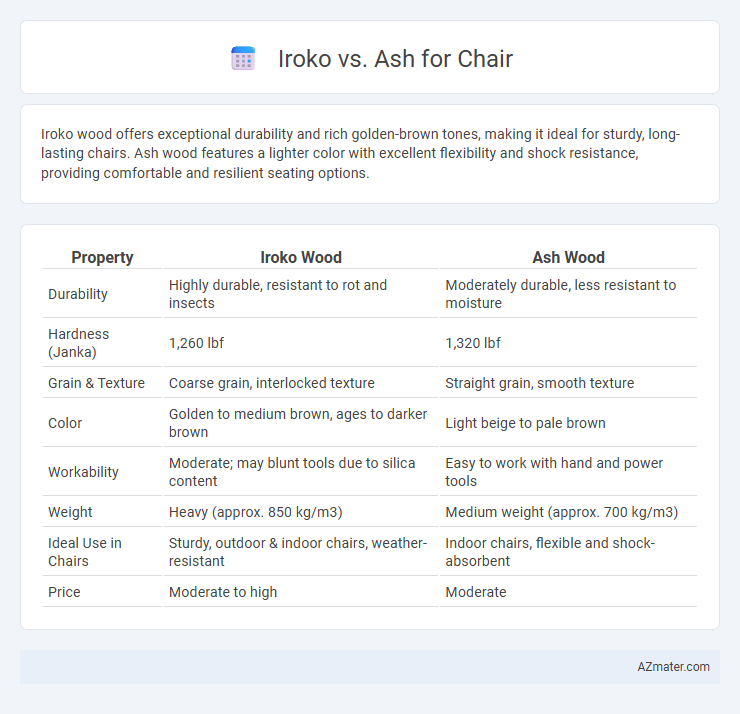Iroko wood offers exceptional durability and rich golden-brown tones, making it ideal for sturdy, long-lasting chairs. Ash wood features a lighter color with excellent flexibility and shock resistance, providing comfortable and resilient seating options.
Table of Comparison
| Property | Iroko Wood | Ash Wood |
|---|---|---|
| Durability | Highly durable, resistant to rot and insects | Moderately durable, less resistant to moisture |
| Hardness (Janka) | 1,260 lbf | 1,320 lbf |
| Grain & Texture | Coarse grain, interlocked texture | Straight grain, smooth texture |
| Color | Golden to medium brown, ages to darker brown | Light beige to pale brown |
| Workability | Moderate; may blunt tools due to silica content | Easy to work with hand and power tools |
| Weight | Heavy (approx. 850 kg/m3) | Medium weight (approx. 700 kg/m3) |
| Ideal Use in Chairs | Sturdy, outdoor & indoor chairs, weather-resistant | Indoor chairs, flexible and shock-absorbent |
| Price | Moderate to high | Moderate |
Introduction to Iroko and Ash Wood
Iroko wood, often referred to as "African teak," is a durable hardwood known for its rich golden to medium brown color and natural resistance to decay, making it ideal for chair construction. Ash wood, prized for its light color and pronounced grain pattern, offers exceptional strength and flexibility, contributing to ergonomic and resilient seating designs. Both woods bring unique aesthetic and structural benefits to furniture, with Iroko providing long-lasting weather resistance and Ash delivering a balanced combination of toughness and springiness.
Origin and Availability of Iroko and Ash
Iroko wood, native to West Africa, is prized for its durability and natural resistance to decay, making it a popular choice for high-quality furniture like chairs. Ash, primarily sourced from North America and Europe, is known for its flexibility and light color, often available in large quantities due to sustainable forestry practices. Iroko's limited availability outside its native regions often results in higher costs compared to the more readily accessible and widely distributed ash wood.
Appearance and Color Comparison
Iroko wood features a rich golden to medium brown hue with occasional darker streaks, offering a warm and natural appearance ideal for elegant chair designs. Ash wood presents a lighter, creamy to pale brown color with a distinct straight grain pattern, providing a bright and clean look that emphasizes simplicity and modernity. The visual contrast between Iroko's deeper tones and Ash's lighter shades significantly influences chair aesthetics, catering to diverse interior styles from traditional to contemporary.
Grain and Texture Differences
Iroko wood features a coarse, interlocking grain with a rough texture that offers a rustic yet durable finish, making it ideal for sturdy chairs with a distinctive look. Ash wood presents a straight, pronounced grain with a smooth, even texture that provides a sleek, refined appearance, favored for ergonomic and lighter chair designs. The contrast between Iroko's variegated grain and Ash's consistent grain influences both the visual appeal and tactile experience of wooden chairs.
Strength and Durability Analysis
Iroko wood offers exceptional strength with a Janka hardness rating of approximately 1,120 lbf, making it highly resistant to wear and dents, ideal for long-lasting chair construction. Ash wood, known for its flexibility and shock resistance, has a slightly lower Janka hardness around 1,320 lbf, providing excellent durability while allowing for comfortable seating support. Both woods exhibit significant durability in chair manufacturing, but Iroko's natural oily content enhances decay resistance, whereas Ash's lightweight qualities contribute to easier handling and maintenance.
Workability for Chair Making
Iroko wood offers moderate workability with natural oils that can dull tools but provides excellent durability and resistance to wear, making it suitable for sturdy chair frames. Ash wood is highly favored for chair making due to its exceptional workability, smooth finish, and flexibility, allowing for intricate designs and comfortable seating. Both woods balance strength and workability, but ash is preferred when ease of shaping and finishing are critical in chair production.
Resistance to Moisture and Decay
Iroko wood exhibits exceptional resistance to moisture and decay, making it a durable choice for chairs used in humid or outdoor environments. Ash wood offers moderate moisture resistance but is more prone to decay if exposed to prolonged damp conditions without proper treatment. Selecting Iroko ensures greater longevity and structural integrity in settings where moisture exposure is a significant concern.
Cost and Sustainability Factors
Iroko wood, often priced higher than ash, offers exceptional durability and natural resistance to decay, making it a sustainable choice for outdoor chairs with longer lifespans. Ash wood is more affordable and widely available, boasting excellent shock resistance and ease of machining, though it may require more maintenance and protective treatments to ensure longevity. Both woods present eco-friendly options when sourced from responsibly managed forests, but iroko's slow growth and water-resistant properties position it as a premium sustainable material in chair manufacturing.
Ideal Chair Styles for Iroko and Ash
Iroko wood, prized for its rich golden to dark brown hues and natural resistance to decay, is ideal for crafting mid-century modern and rustic-style chairs that emphasize durability and organic texture. Ash wood offers exceptional flexibility and a light, creamy color, making it perfect for Scandinavian, Shaker, or contemporary chair designs prioritizing ergonomic curves and a sleek, minimalist aesthetic. Both woods excel in producing sturdy chairs, but Iroko suits outdoor or heavy-use pieces, while Ash is favored for indoor seating that requires intricate shaping and smooth finishes.
Which is Better: Iroko or Ash for Chairs?
Iroko wood offers superior durability and natural resistance to moisture, making it ideal for chairs that require longevity and minimal maintenance. Ash wood provides a lighter weight and excellent flexibility, resulting in comfortable, ergonomic chairs with a stylish, smooth grain pattern. When choosing between Iroko and Ash for chairs, Iroko is better for outdoor or high-traffic use due to its toughness, while Ash suits indoor settings where aesthetic appeal and comfort are prioritized.

Infographic: Iroko vs Ash for Chair
 azmater.com
azmater.com